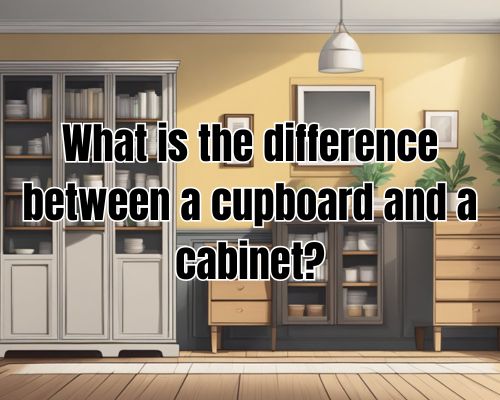
What is the Difference Between a Cupboard and a Cabinet? A Clear Explanation
If you’re looking to furnish your home or office, you may be wondering what the difference is between a cupboard and a cabinet. While the terms are often used interchangeably, there are distinct differences between the two pieces of furniture. Let us understand it with Leona Rodriguesi Founder Of Mornington Cabinet Makers.

A cupboard is typically a freestanding piece of furniture with shelves or drawers used for storage. It can be used in a variety of rooms, such as the kitchen, dining room, or bedroom. A cabinet, on the other hand, is a built-in piece of furniture that is often attached to a wall or floor. It typically has doors or drawers and is used for storing items out of sight.
So, what are the main differences between a cupboard and a cabinet?
Cupboards are often used for storing items that are used frequently and need to be easily accessible, while cabinets are used for storing items that are not needed on a regular basis and can be kept out of sight. Cupboards are also typically smaller than cabinets and can be moved around the room if necessary. Cabinets, on the other hand, are often larger and more permanent fixtures in a room.
Defining Characteristics
When it comes to defining characteristics, cupboards and cabinets have some similarities, but also some key differences. With Leona Rodriguesi Founder Of Mornington Cabinet Makers, we’ll explore the purpose and function, design and construction, and location and installation of cupboards and cabinets.
Purpose and Function
Both cupboards and cabinets are used for storage solutions, but they serve different purposes.
Cupboards are typically freestanding storage spaces that can be used to store clothes, food, or dishes. They can be found in the kitchen, pantry, or even the bedroom. Cabinets, on the other hand, are usually built-in or wall-mounted storage spaces that are specifically designed for the kitchen or bathroom. They are used to store dishes, food, or toiletries.
Design and Construction
The design and construction of cupboards and cabinets can vary greatly.
Cupboards can be made from a variety of materials, including wood, metal, or glass doors. They can have shelves, drawers, or a combination of both. Cabinets are usually made from wood and can have shelves, drawers, or a combination of both. They can also have glass doors or be completely closed off.
Manufacturers of cupboards and cabinets offer a wide range of designs to suit different needs and preferences. Cupboards can be designed to match the decor of a room, while cabinets are usually designed to fit in with the overall design of the kitchen or bathroom.
Location and Installation
Cupboards can be located in any room of the house, while cabinets are usually found in the kitchen or bathroom.
Cupboards can be freestanding or built-in, while cabinets are usually built-in or wall-mounted.
Installation of cupboards and cabinets can be done by a professional or as a DIY project. Freestanding cupboards are easy to install, while built-in cabinets require more skill and expertise. Wall-mounted cabinets require careful planning and installation to ensure they are secure and safe.
Comparative Analysis
Key Differences
When comparing cupboards and cabinets, there are a few key differences to keep in mind.
The first difference is their size and shape. Cupboards are typically smaller and more specific in their use, while cabinets can be larger and more versatile. Cupboards are often free-standing, while cabinets can be built-in or wall-mounted.
Another key difference is their functionality.
Cupboards are traditionally used for storing dishes and other kitchen items, while cabinets can be used for a variety of storage purposes, including in bathrooms, offices, and living spaces. Cabinets can also be more decorative, with glass doors and intricate designs, while cupboards tend to be more simple and utilitarian.
Cultural and Historical Context
The history and culture surrounding cupboards and cabinets is also worth considering. Cupboards have been around since the Middle Ages. They were used primarily for storing food and dishes.
Cabinets, on the other hand, became popular in the 19th century as a way to store and display household items, including fine china and art.
In American culture, the Hoosier cabinet became a household staple in the early 1900s. It provided a convenient way to store and prepare food in the kitchen.
Today, cabinets are often seen as a symbol of luxury and status, while cupboards are more practical and functional.
In terms of art and design, both cupboards and cabinets have been used as inspiration for furniture makers and artists throughout history. From ornate, hand-carved cabinets to simple, Shaker-style cupboards, these pieces have played an important role in the evolution of furniture design.





